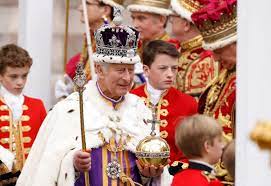The Coronation of King Charles III

The coronation of King Charles was held on Saturday May 6. The last coronation was 70 years ago for Queen Elizabeth.
On Saturday, May 6, 2023, the coronation of King Charles III took place with hundreds of thousands attending lining the streets of London and hundreds of millions of people watching on television and streaming devices all around the world. Watching the crowning of the new King and Queen of England, which took place in the infamous cathedral, Westminster Abbey, it was abundantly clear the deep religious symbolism, stemming from Christian rituals and beliefs, was the foundation of the ceremony. In fact, the coronation of King Charles II and Catholicism is connected in several ways, both historically and culturally.
The coronation ceremony, although a celebration of holy communion in an Anglican liturgy (Church of England) on Saturday, actually dates back thousands of years to the Catholic Church. Westminster Abbey was once a Catholic monastery. The coronation of a King or Queen of England originally was centered around the Catholic Eucharist and includes the act of anointing, which has deep Judeo-Christian biblical roots. The ceremony now takes place in an Anglican church, however the celebration of the Eucharist and most of the rituals look and feel and resemble the traditional Catholic ceremony. The British monarchy broke away from the Catholic Church in 1534 under King Henry VIII. King Charles is considered the Supreme Governor of the Church of England and took an oath during the ceremony to uphold the Protestant faith. In 1521, Pope Leo X gave the title of the “Defender of the Faith” to King Henry VIII before he broke away from the Church.
A Catholic priest, Cardinal Vincent Nichols of Westminster, participated in the coronation on Saturday, offering a blessing after the crowning; a testament to the Catholic heritage and tradition of this ceremony. 70 years ago, a Catholic would not have been permitted in an Anglican church, let alone participate in a coronation. This is the first time in over 400 years that a Catholic Archbishop has had a role in a British coronation, a historic event toward strengthening Catholic-Anglican relations. Cardinal Nichols is pictured in red vestments and zucchetto (the red cap).
Last month Pope Francis gifted to King Charles III two pieces of the wooden cross that Jesus was crucified on. The two chards of wood were inlaid into the newly made Cross of Wales. Wales is part of the United Kingdom and the heir to the throne is the Prince of Wales. The cross is made of Welsh slate, wood and silver. The Welsh words of St. David, the Catholic patron saint of Wales, are inscribed on the cross “Be Joyful. Keep the Faith. Do the Little Things.” At the center of the cross are the two tiny chards of wood arranged into a cross.
Another part of the coronation included the anointing of King Charles’ head, hands and breast with chrism oil, which the Catholic Church also uses for baptism and confirmation. This part of the ceremony was done behind a screen near the altar and is the King’s only moment of privacy where he is “to contemplate how he is called by God;” the canopy and screen symbolize “the embrace, enveloping power, and presence of God during this moment” according to the Church of England. The oil used for the anointing is made from olives from the Mount of Olives and was consecrated in the Church of the Holy Sepulchre in Jerusalem, which is the traditional site of the death and resurrection of Jesus.
The Ampulla is a small golden eagle that contains the chrism oil and based on a 14th century legend which the Virgin Mary appeared to St. Thomas Becket and gave him a golden eagle and vial of oil for anointing future kings of England. The oil is poured into a silver coronation spoon which is the oldest object used in the ceremony dating back to 1349.
Many of the scepters, orbs and swords used during the ceremony have symbols of crosses and other Christian traditions further underscoring that this coronation ceremony is richly full of symbols of Christ.
The final most Christian moment or tradition at the coronation was when the newly anointed King and Queen received communion. This past weekend’s coronation was a beautiful ceremony illustrating a deep cultural, historical, and most importantly spiritual example of God and country.

Annelise Motto was born in San Francisco. She moved from the Bay Area to San Diego last year. She is a senior at Cathedral Catholic High School. She played...




















































